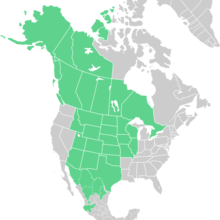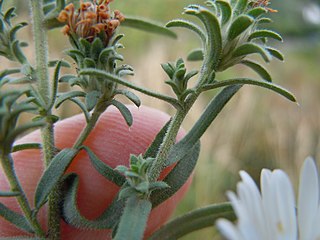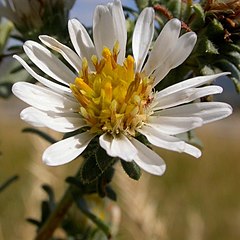Symphyotrichum falcatum
| Symphyotrichum falcatum | |
|---|---|

| |
| Scientific classification | |
| Kingdom: | Plantae |
| Clade: | Tracheophytes |
| Clade: | Angiosperms |
| Clade: | Eudicots |
| Clade: | Asterids |
| Order: | Asterales |
| Family: | Asteraceae |
| Tribe: | Astereae |
| Subtribe: | Symphyotrichinae |
| Genus: | Symphyotrichum |
| Subgenus: | Symphyotrichum subg. Virgulus
|
| Species: | S. falcatum
|
| Binomial name | |
| Symphyotrichum falcatum | |
| Varieties[2] | |

| |
| Native distribution[2][3] | |
| Synonyms[2] | |
|
Basionym
Species var. commutatum[4]
| |
Symphyotrichum falcatum (formerly Aster falcatus) is a
Description
White prairie aster blooms July–November depending on variety and location. It is
On the outside of the
The flower heads have 15–35 usually white
-
Bracts, involucres, and phyllaries.
-
Close-up of ray and disk florets
Chromosomes
Symphyotrichum falcatum has a base number of x = 5.
- S. spathulatum var. falcatum: 2n = 2x = 10, 2n = 4x = 20, and 2n = 6x = 30.[9]
- S. spathulatum var. commutatum: 2n = 6x = 30.[3]
Taxonomy
Symphyotrichum falcatum is one of the two species within Symphyotrichum sect. Ericoidei. The other is S. ericoides.[10] The species was first formally described by John Lindley in 1834 as Aster falcatus.[11]
Two varieties are recognized:
- S. falcatum var. falcatum,
- S. falcatum var. commutatum,
S. falcatum is one of the parents of the two
Distribution and habitat
S. falcatum var. falcatum is native from Alaska, Yukon, and Northwest Territories in the north, western Canada from British Columbia to Manitoba, in the United States from Idaho east to Minnesota, west to Wyoming and south to New Mexico and Arizona, then north to Utah. It is also native to northern Mexico.[2]

S. falcatum var. commutatum has no
Conservation
NatureServe lists it as Secure (G5) worldwide, Critically Imperiled (S1) in Alaska, Imperiled (S2) in Manitoba, Vulnerable (S3) in Yukon, and Possibly Extirpated (SH) in Iowa. It is an exotic species in Ontario, Missouri, and Massachusetts.[1]
Uses
The Zuni people call S. falcatum var. commutatum by the name ha'mopiawe and mix the ground blossoms with yucca suds to wash newborn infants.[15] Quoting American ethnologist Matilda Coxe Stevenson:
The blossoms, ground to a fine meal, are sprinkled into a bowl of yucca suds used for bathing a new-born infant. This medicine is said to make the hair grow on the head and to give strength to the body. The remedy belongs to all women.[15]
The Ramah Navajo use the plant in a decoction to make a lotion as a remedy for snake bites.[16]
Notes
- ^ See Asteracae § Flowers for more detail.
Citations
- ^ a b NatureServe 2021.
- ^ a b c d e POWO 2021a.
- ^ a b Brouillet et al. 2006b.
- ^ a b POWO 2021b.
- ^ USDA, NRCS 2014.
- ^ a b c d e Brouillet et al. 2006a.
- ^ Morhardt & Morhardt 2004, p. 29.
- ^ a b Semple n.d.
- ^ Brouillet et al. 2006c.
- ^ Semple 2019.
- ^ IPNI 2020.
- ^ GBIF Secretariat 2019a.
- ^ GBIF Secretariat 2019b.
- ^ Semple 2021.
- ^ a b Stevenson 1915, p. 84.
- ^ Vestal 1952.
References
- Brouillet, L.; Semple, J.C.; Allen, G.A.; Chambers, K.L.; Sundberg, S.D. (2006a). "Symphyotrichum falcatum". In Flora of North America Editorial Committee (ed.). Flora of North America North of Mexico (FNA). Vol. 20. New York and Oxford: Oxford University Press. Retrieved 23 July 2021 – via eFloras.
- Brouillet, L.; Semple, J.C.; Allen, G.A.; Chambers, K.L.; Sundberg, S.D. (2006b). "Symphyotrichum falcatum var. commutatum". In Flora of North America Editorial Committee (ed.). Flora of North America North of Mexico (FNA). Vol. 20. New York and Oxford: Oxford University Press. Retrieved 23 July 2021 – via eFloras.
- Brouillet, L.; Semple, J.C.; Allen, G.A.; Chambers, K.L.; Sundberg, S.D. (2006c). "Symphyotrichum falcatum var. falcatum". In Flora of North America Editorial Committee (ed.). Flora of North America North of Mexico (FNA). Vol. 20. New York and Oxford: Oxford University Press. Retrieved 23 July 2021 – via eFloras.
- GBIF Secretariat (2019a). "Symphyotrichum falcatum (Lindl.) G.L.Nesom". gbif.org. GBIF Secretariat. Retrieved 24 November 2020.
- GBIF Secretariat (2019b). "Symphyotrichum falcatum var. commutatum (Torr. & A.Gray) G.L.Nesom". gbif.org. GBIF Secretariat. Retrieved 24 November 2020.
- IPNI (2020). "Aster falcatus Lindl". International Plant Names Index (IPNI). Royal Botanic Gardens, Kew; Harvard University Herbaria & Libraries; Australian National Botanic Gardens. Retrieved 24 November 2020.
- Morhardt, S.; Morhardt, E. (2004). California Desert Flowers: An Introduction to Families, Genera, and Species. Berkeley, Los Angeles, and London: ISBN 0520240030.
- Arlington, Virginia: NatureServe. Retrieved 23 July 2021.
- POWO (2021a). "Symphyotrichum falcatum (Lindl.) G.L.Nesom". Plants of the World Online. Royal Botanic Gardens, Kew. Retrieved 23 July 2021.
- POWO (2021b). "Symphyotrichum falcatum var. commutatum (Torr. & A.Gray) G.L.Nesom". Plants of the World Online. Royal Botanic Gardens, Kew. Retrieved 23 July 2021.
- Semple, J.C. (n.d.). "Symphyotrichum subg. Ascendentes". University of Waterloo (UWaterloo.ca). Waterloo, Ontario: University of Waterloo. Archived from the original on 22 July 2021. Retrieved 23 July 2021.
- Semple, J.C. (16 October 2019). "Virguloid Asters". University of Waterloo (UWaterloo.ca). Waterloo, Ontario: University of Waterloo. Archived from the original on 23 July 2021. Retrieved 23 July 2021.
- Semple, J.C. (14 May 2021). "Symphyotrichum ascendens — Long-leaved Aster, Intermountain Aster, Western Aster". University of Waterloo (UWaterloo.ca). Waterloo, Ontario: University of Waterloo. Archived from the original on 22 July 2021. Retrieved 23 July 2021.
- Stevenson, M.C. (1915). "Ethnobotany of the Zuñi Indians". Smithsonian Institution-Bureau of American Ethnology (SI-BAE) Annual Report. 30. Washington: U.S. Government Printing Office: 84. Retrieved 23 July 2021 – via Biodiversity Heritage Library.
- USDA, NRCS (2014). "Symphyotrichum falcatum". The PLANTS Database (plants.usda.gov). Greensboro, North Carolina: National Plant Data Team. Retrieved 23 July 2021.
- Vestal, P.A. (1952). "The Ethnobotany of the Ramah Navaho". Papers of the Peabody Museum of American Archaeology and Ethnology. 40 (4): 48. Retrieved 23 July 2021 – via abstract at Native American Ethnobotany DB (naeb.brit.org).
External links
- Symphyotrichum falcatum in the CalPhotos photo database, University of California, Berkeley



